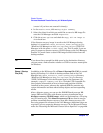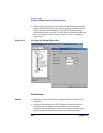
Disaster Recovery
Enhanced Automated Disaster Recovery of a Windows System
Chapter 10468
(create it if you have not created it already).
4. In the Results Area, click Backup Object Summary.
5. Select the client for which you would like to store its DR image file
onto the Cell Manager and click Properties.
6. Click the WinFS Options and check the Copy full DR image to
disk check box.
If the disaster recovery image is saved to the Cell Manager during
backup, it is stored into <Data_Protector_home>\Config\dr\p1s
(Windows Cell Manager) or into /etc/opt/omni/dr/p1s (UNIX Cell
Manager) with the name <client name>.img. This is useful if you are
going to prepare a disaster recovery CD ISO image on the Cell Manager,
because it is much faster to obtain DR image from disk than from the
backup medium.
TIP If you do not have enough free disk space in the destination directory,
you can create a link to another volume on UNIX or create a mount point
on Windows.
Phase 1 Startup
File (P1S)
In addition to the DR image file, a Phase 1 Startup file (P1S) is created
during full backup. It is saved on backup medium and on the Cell
Manager into <Data_Protector_home>\Config\dr\p1s directory
(Windows Cell Manager) or into /etc/opt/omni/dr/p1s directory
(UNIX Cell Manager) with the filename equal to the hostname (for
example, computer.company.com). It is a Unicode UTF-8 encoded file
that contains information on how to format and partition all disks
installed in the system, whereas the updated SRD file contains only
system information and data about backup objects and corresponding
media.
After a disaster occurs, you can use the EADR Wizard to merge DR
image, SRD and P1S files with disaster recovery installation into a
disaster recovery CD ISO image, which can be burned on a CD using
any CD burning tool. This disaster recovery CD can then be used to
perform automated disaster recovery. Note that disaster recovery CD
has to be prepared in advance for the Cell Manager. Additional steps are
required if you are preparing disaster recovery CD of a Microsoft Cluster
node. See “Restoring the Microsoft Cluster Server Specifics” on page 490.


















